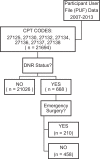Comparison of Postoperative Outcomes in Elderly Patients With a Do-Not-Resuscitate Order Undergoing Elective and Nonelective Hip Surgery
- PMID: 28540112
- PMCID: PMC5431406
- DOI: 10.1177/2151458516685826
Comparison of Postoperative Outcomes in Elderly Patients With a Do-Not-Resuscitate Order Undergoing Elective and Nonelective Hip Surgery
Abstract
Purpose: Emergency hip surgery generally has worse outcomes than elective hip surgery, even when adjusted for patient and surgical factors. Do-not-resuscitate (DNR) status patients are typically at higher perioperative risk and undergo a narrow range of surgical procedures. We aimed to compare the outcomes after hip surgery of differing degrees of urgency in this cohort.
Materials and methods: Using National Surgical Quality Improvement Program (NSQIP) data, we conducted univariate and multivariate analyses comparing outcomes of DNR status patients after emergency and nonemergency hip surgery (2007-2013). We conducted a subanalysis of mortality in elective versus nonelective cases (elective variable introduced from 2011).
Results: Of 668 hip surgery cases in DNR status patients, 210 (31.4%) were emergency and 458 (68.8%) were nonemergency. There were no significant associations between emergency and nonemergency surgery regarding patient demographics, comorbidities, functional capacity, anesthesia type, or operative duration. There was no significant difference in the 30-day postoperative mortality between emergency (21.4%) and nonemergency (16.4%) or between elective (19.6%) and nonelective (18.3%) hip fracture surgeries performed in patients with preexisting DNR status. Morbidity patterns in emergency vs nonemergency cases demonstrated no significant differences, with the commonest 3 complications being transfusion (21.0% and 21.4%, respectively), urinary tract infection (9.5% and 7.9%, respectively), and pneumonia (both at 5.2%). The 30-day home discharge rates were low at 4.7% and 5.6%, respectively. Multivariate analysis demonstrated no significant associations between emergency and nonemergency surgery for mortality, discharge destination, length of stay or complications, except perioperative myocardial infarction (3.7% vs 1.3%, P < .04).
Conclusion: For patients with DNR status, both emergent and non-emergent hip surgery carries high mortality, greatly exceeding rates predicted for that patient by American College of Surgeons NSQIP risk calculators. Morbidity rates and patterns for patients with DNR status are also similar in emergency and nonemergency groups. These data may be useful in discussing risk and obtaining adequately informed consent in DNR patients undergoing hip surgery.
Keywords: DNR; do not resuscitate; elective; emergency; hip fracture; hip surgery; informed consent.
Conflict of interest statement
Declaration of Conflicting Interests: The author(s) declared no potential conflicts of interest with respect to the research, authorship, and/or publication of this article.
Figures



References
-
- Kazaure H, Roman S, Sosa JA. High mortality in surgical patients with do-not-resuscitate orders: analysis of 8256 patients. Arch Surg. 2011;146(8):922–928. - PubMed
-
- Le Manach Y, Collins G, Bhandari M, et al. Outcomes after hip fracture surgery compared with elective total hip replacement. JAMA. 2015;314(11):1159–1166. - PubMed
-
- Mohanty S, Rosenthal RA, Russell MM, Neuman MD, Ko CY, Esnaola NF. Optimal perioperative management of the geriatric patient: best practices guideline from ACS NSQIP®/American Geriatrics Society. J Am Coll Surg. 2016;222(5):930–947. - PubMed
-
- Dall TM, Gallo PD, Chakrabarti R, West T, Semilla AP, Storm MV. An aging population and growing disease burden will require a large and specialized health care workforce by 2025. Health Aff (Millwood). 2013;32(11):2013–2020. - PubMed
LinkOut - more resources
Full Text Sources
Other Literature Sources

